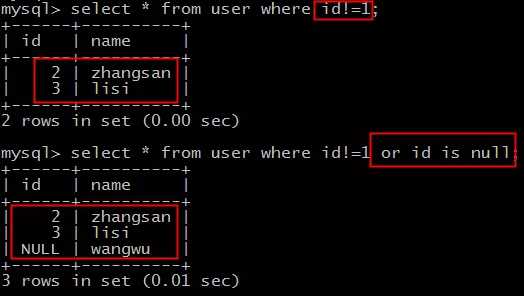标签:into 优化 4行 合并 附加 HERE xpl 默认 pac
原文:
create table user ( id int, name varchar(20), index(id) )engine=innodb; insert into user values(1,‘shenjian‘); insert into user values(2,‘zhangsan‘); insert into user values(3,‘lisi‘);
说明:id为索引,非唯一(non unique),允许空(null)。
explain select * from user where id!=1;
索引字段id上的不等于查询,如上图所示:(1)type=ALL,全表扫描;(2)rows=3,全表只有3行;
insert into user(name) values(‘wangwu‘);
先构造一条id为NULL的数据,可以看到共有4条记录。
select * from user where id!=1;
再次执行不等于查询。你猜结果集有几条记录(共4条,不等于排除1条)?答错了!结果集只有2条记录,空值记录记录并未出现在结果集里。

select * from user where id!=1 or id is null;
如果想到得到符合预期的结果集,必须加上一个or条件。
画外音:恶心不恶心,这个大坑你踩过没有?
知识点3(附加):某些or条件,又可能导致全表扫描,此时应该优化为union。

explain select * from user where id=1;
索引字段id上的等值查询,能命中索引,如上图所示:(1)type=ref,走非唯一索引;(2)rows=1,预估扫描1行;

explain select * from user where id is null;
索引字段id上的null查询,也能命中索引,如上图所示:(1)type=ref,走非唯一索引;(2)rows=1,预估扫描1行;

explain select * from user where id=1 or id is null;
如果放到一个SQL语句里用or查询,则会全表扫描,如上图所示:(1)type=ALL,全表扫描;(2)rows=4,全表只有4行;

explain select * from user where id=1 union select * from user where id is null;
此时应该优化为union查询,又能够命中索引了,如上图所示:(1)type=ref,走非唯一索引;(2)rows=1,预估扫描1行;
画外音:第三行临时表的ALL,是两次结果集的合并。
总结:
(1)负向比较(例如:!=)会引发全表扫描;
(2)如果允许空值,不等于(!=)的查询,不会将空值行(row)包含进来,此时的结果集往往是不符合预期的,此时往往要加上一个or条件,把空值(is null)结果包含进来;
(3)or可能会导致全表扫描,此时可以优化为union查询;
(4)建表时加上默认(default)值,这样能避免空值的坑;
(5)explain工具是一个好东西;
标签:into 优化 4行 合并 附加 HERE xpl 默认 pac
原文地址:https://www.cnblogs.com/huanshilang/p/12153355.html